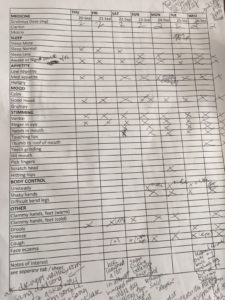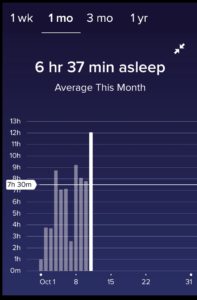Doctor’s Appointment? Do’s and Don’ts for A Productive Visit
Got a doctor’s appointment coming up? Oh my friend, I feel your pain! Being Jack’s mom means my dance card is filled with such activities. Through trial and error, I have gotten better at these appointments, but I want to prevent you from making my rookie mistakes. Fear not, you can do this!
DON’T Drown Doctors In Details
Anyone who knows me knows I can have my moments of chattiness. My nervousness can make this tendency worse. Throw in caffeine? Hello Anxiety!
Typical scenario: One of Jack’s doctors would ask me a question. I’d attempt to give him my fullest answer. I’d get maybe halfway through my response, start rambling and get:

Dr. Evil (he’s not Jack’s doctor!)
(Ok, he didn’t actually say that!) The doctor got the info he needed, so he moved along to his next question. The abruptness served only to throw me off my game. And thus my downward spiral began.
I see now that I failed to consider my audience. Doctors are a mostly data driven, analytical folk. They are also overworked. Help them help your child by sticking to the essentials. In other words, don’t be me from 10-15 years ago.
DON’T Be A Mom (Or Dad!) Of Few Words
I needed a different plan of attack–better to fit those 15 minute appointment blocks of Jack’s busy professionals. After getting cut off mid-sentence a time or two, I changed strategy. I thought: Action words, NOT filler words! Keep main points up front! Keep the doctor’s attention! And so I found myself using a tortured Yoda/Haiku-like prose in order to not be interrupted.
Jack’s sleeping not well
Working, it’s not, all we’ve tried
Help please, sleep I need

Who doesn’t love Yoda?!
Over-correction was ineffective . So “less is more” didn’t work either. Gradually, I figured out how to make the most of Jack’s doctor appointments.
DO Make A Chart
Data is key and if you can bring in numbers–EVEN BETTER! If you are seeing a doctor for your child’s chronic condition, chart the issue for a few weeks. Bring your chart to the appointment. Doesn’t have to be fancy—or even typed, if that’s not your thing.
Charting Vs. Journaling
Jack has always had sleep issues. Years ago, I might have noted his sleep in short journal entries. Not only was it difficult to see patterns, but then I’d forget to record notes some days. Gradually life happened, time passed and my journaling ceased. The doctor’s appointment loomed, and I’d be left relying solely on my intuition.
Chart To Fit Your Life
Nowadays I’m more realistic about what I can accomplish. Our tracking system fits our life. Jack has been on a new medication so we track a ton of behaviors daily. Once you create a chart, you can observe more things efficiently.
How do we do it? I chart Jack’s stuff at mealtimes when I’m feeding him. I’m already sitting next to him and I always keep the chart and a pen by his place. I check a few boxes—I’m done!! I might jot something else down at other times but I’m guaranteed data collection twice a day, minimum.

Jack’s weekly data collection sheet
Later on, Mike compiles the weekly data sheets into one high level chart for the doctors. And we highlight any patterns we have noticed. We bring this handout to give our doctors during the appointment (and send an electronic copy via e-mail).
Charting gives doctors better information. By charting daily, you can see trends.

Jack’s high level sleeping chart for his doctors (Thanks Mike!)
DO Automate Tracking When Possible!
We live in a technological wonderland, with many tracking tools. We have been monitoring Jack’s sleep, so I purchased a Fitbit. That not only tracked his sleep, but also his resting heart rate, and activity level for even more data.
The Fitbit certainly isn’t 100% accurate 100% of the time. Obviously, it is not a professional grade scientific instrument. However, it’s better than nothing.
We look at the Fitbit data daily and see if it makes sense. Often it validates our observations. So when the doctor asks about the number of nights per week Jack is awake, I have a more qualified answer at my fingertips!

Fitbit data chart
DO Use Photos Or Videos If Applicable
If your child has a rash, for example, take a picture of it on your phone! (Again, yay technology! Goodbye clunky digital camera that I can never find when I need it). If there is a behavioral issue, use your phone’s video function. Jack had problems walking a few years ago (intermittently), so I would video his walking at home.
Photos and videos can show the doctor an issue that may be invisible during a 15 min apt.
In A Nutshell
• Don’t Overtalk the problem
• Don’t Undertalk the problem
• Do Be Methodical In Observing Your Child’s Issue
• Do Use Technology to help you get there whenever possible!
That’s it! I hope these tips help you navigate the world of specialists. Doctors may be experts in their fields, but YOU are the expert of your child—never forget that. Visiting the specialists is like anything else in life—practice makes perfect. Jack has been to many over the years. From Audiology to Neurology—Orthopedics to Gastroenterology– you name it and chances are, I’ve filled out a 20 page patient history packet for it! Learn from my mistakes—the more you prepare, the better your chances for a productive visit. And I’ll see you in the waiting room!

I’m the mom of 2 great young adults, as well as of a very spoiled plott hound named Bubba Sue. I grew up in New Jersey, but have lived in the Cincinnati, OH area for the past 18 years. My husband Mike and I have been married for long enough not to look like our wedding pictures, but even after all these years, he still makes me laugh. After 15 years of questions and no answers, Jack got a diagnosis of Smith-Kingsmore Syndrome. I wanted to write this blog to help special needs families know they are not alone.
